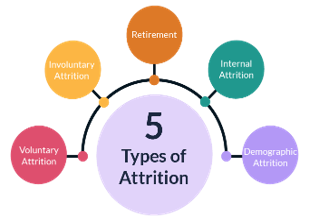
Employee Attrition In the Workplace
Introduction
- In the ever-changing modern workplace, employee attrition is a phenomenon that has long been present. It has, however, increased recently.
- The process through which a workforce gradually loses members is known as employee attrition. Over time, a variety of causes cause employees to leave the firm.
Table of content
- Introduction.
- How to calculate the attrition rate?
- Types of attrition.
- Reasons?
- Strategies to improve or reduce attrition.
- Conclusion.
- Bibliography.
How to calculate attrition rate?
The computation is straightforward to calculate the attrition rate
Attrition Rate = Number of voluntary employee departures in a month or year/ average number of employees during that month or year x 100
Your attrition rate ought to be under 10%, ideally.
The term “attrition” also refers to the loss of consumers or clients.
The loss of a devoted customer base or clients or employees can have a negative impact on an organization’s ability to generate income.

Types of Attrition
1. Voluntary Attrition:-
Voluntary attrition is the most prevalent kind. Here, the workers voluntarily depart or resign from their positions inside the company. Employees have control over it. There may be different reasons:-
- Lack of opportunities for learning & growth.
- Better pay opportunities.
- Lack of appreciation.
- Extended period of stress.
2. Involuntary Attrition:-
When workers are let go by their employer without their will, attrition of this kind takes place. They are forced to make the decision; their consent is not considered. Employees have no control over the factors that led to the choice, such as layoffs, terminations, and restructuring. Such attrition can be caused by changes in organizational strategies, performance concerns, or budgetary limitations.
3. Retirement:-
This kind of attrition happens when workers leave their jobs before they reach a certain age. The personal choice made by the employee and the work routine based on age, health, and financial preparedness is tied to this attrition.
Plans for addressing retirement attrition by providing retirement benefits must be made by organizations. Additionally, it’s critical to identify retiring personnel in advance in order to fill the positions they leave behind.
4. Internal Attrition:-
Employees choose to leave their existing position in favor of a newer one while still working for the same company in this sort of attrition. A total change to a different function and department may also occur.
This attrition may even be considered advantageous in certain situations since it allows workers to go to a different department where they can thrive.
Seeking possibilities for career growth and organizational change may be some of the driving forces for this move.
5.Demographic Attrition:-
This kind of attrition occurs when a particular group of workers departs the company at a faster pace than other groups. The demography may consist of a particular gender, ethnicity, or age range.
It usually arises from disparities between different demographic groups’ career aspirations, opportunities, and job experiences.
To lower attrition among particular demographics, organizations should be aware of these trends, encourage diversity and inclusion, and deal with underlying problems.

Reasons for Employee Attrition
1.Toxic Workplace Culture:-
The culture of the company is one of the main causes of employee attrition. Employee stress and discontent can reach dangerous heights in a poisonous work environment.
A bad workplace culture can be caused by a variety of elements, including micromanagement, poor communication, and a lack of transparency.
- Lack of Diversity and Inclusion:-
The way the company handles diversity and inclusion can also have an effect on employee churn.
Employees from underrepresented groups may feel alone and alienated if they perceive themselves as excluded. They frequently look elsewhere for a more welcoming environment as a result of this.
- Lack of Recognition and Appreciation:-
Research indicates that 79% of individuals who resign from their positions give “lack of appreciation” as their cause.Workers who believe their employer does not value or recognize their accomplishments are more likely to leave the company.Consider a worker who constantly goes above and above in their work but never gets acknowledged or praised.
- Job Insecurity:-
Employee stress and worry might be brought on by rumors of layoffs or regular restructuring, which raise doubts about the stability of their jobs. Consider a business that is having trouble making ends meet and has to reduce its personnel. Employees may feel unstable as a result of this uncertainty and may begin exploring for more stable job prospects elsewhere.Moreover, workers may find it challenging to concentrate on their work when they are anxious about their jobs. It may result in poorer job satisfaction, lower productivity, and eventually increased turnover rates.

Tips to improve or strategies
1. Professional Recruitment Strategy:-
Reducing employee churn requires a robust, professional recruitment approach. It entails more than merely identifying applicants with the necessary abilities. It all comes down to identifying people who share the culture and values of your business.
To begin, draft thorough job descriptions that precisely define the position and its requirements. In order to reach a varied pool of prospects, make use of a range of recruitment methods.
A comprehensive interviewing procedure is also essential. Psychological evaluations and behavioral assessments can offer insightful information about a candidate’s fit with your organization.
2.Enhance Onboarding Facility:-
There is more to a thorough onboarding program than paperwork and orientation. It can help the new workers feel appreciated, at home, and ready for their positions inside your company. Giving new hires a mentor or buddy can make them feel supported right away and help them adjust to their new surroundings. Additionally, it might be beneficial to new workers to have clear goals and expectations so they can grasp their goals & achievements.
3. Do Not Skim Out on the Compensation:-
We are aware that paying your staff handsomely is not always an easy task. It has a negative financial impact on your business.
But, it’s best to avoid going below industry norms or the mean salary your rivals are offering. When the model is balanced, your company’s attrition and turnover rates will decrease.
4.Foster a Positive Work Environment:-
Establish an attitude of support, open communication, and respect at work to create a positive work environment. It will highlight each worker’s greatest qualities. Employees are less inclined to look for work elsewhere when they feel valued and safe.
5.Provide Opportunities for Professional Growth:-
Workers are more likely to stick with an organization that values their professional development. As a result, giving them chances to grow professionally and learn new things strengthens their commitment to the business.

Bibliography
CONCLUSION
Although it might seem inevitable, employee turnover isn’t always the case. Organizations can reduce turnover and retain great people with proper planning and dedication.
Because disregarding retention has too great of a financial and performance cost to the company. It is imperative that to take immediate action as a leader to turn staff retention from an after thought to a strategic objective.
Long-term success of firm can be achieved via the implementation of proactive retention programs that foster employee engagement and stability.

